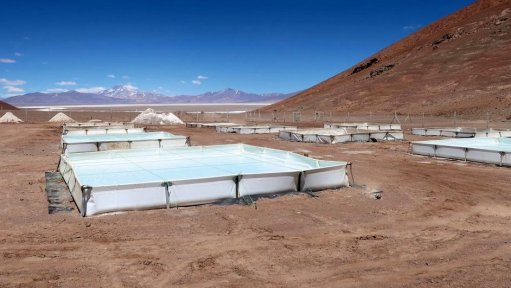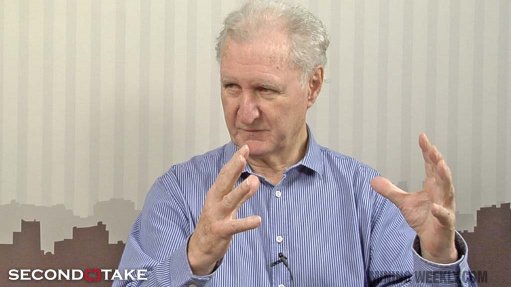Prospects perking up for industrial use of gold – Mintek

Mintek CEO Abiel Mngomezulu expresses optimism to Mining Weekly Online's Martin Creamer on gold's industrial use. Photographs: Duane Daws. Video: Nicholas Boyd and Duane Daws. Editing: Darlene Creamer.
JOHANNESBURG (miningweekly.com) – The prospects for the greater industrial use of gold are increasing encouragingly, the top brass of South Africa’s State-owned minerals research organisation Mintek said this week.
Mintek president and CEO Abiel Mngomezulu and the organisation’s two top gold researchers, Dr Gary Pattrick and Dr Robert Tshikhudo – who were commenting to Mining Weekly Online in a video interview (see attached) – said gold was breaking out of its classical bullion-for-investment and jewellery typecasting across several fronts.
These fronts include carbon monoxide (CO) removal, prevention of atmospheric mercury pollution at coal-fired power stations, cancer therapeutics, obsesity reduction, carbon dioxide (CO2) lasering augmentation, value enhancement of glycerol and ethanol and gluconic acid production for cement setting.
Gold is playing these roles in extremely small particle sizes as tiny as two-billionths of a metre.
The precious metal is becoming increasingly active as a catalyst that oxidises CO, the highly toxic chemical that is released in fires and from car exhausts.
In doing so, it dispenses with its gold colour and takes on a purple hue.
Gold is seen as the most commercially relevant material for the low-temperature removal of CO and with the supply-side solved, observers believe that it is the demand side that needs more work.
In the field of health, Mintek is focusing on using gold nanoparticles for cancer therapeutics and obesity research.
“Gold nanoparticles can be used as a fat reducing agent,” Tshikhudo told Mining Weekly Online.
Mintek is currently able to produce gold catalysts in 65 kg batches, which amounts to a couple of tons a year, in shapes suitable for particular applications.
The research institution's gold catalysts, sold under the AUROlite trademark, are distributed by Strem Chemicals, of the US, a nanotechnology and inorganic specialist company.
Strem sells the gold catalysts to a wide range of researchers, which, in turn, increases the potential for finding even more industrial applications for gold.
Many publications are now making use of the AUROlite name as a recommended material, which is building Mintek’s reputation as a reliable supplier, Pattrick commented to Mining Weekly Online.
To date, Mintek has sold half a ton of this gold catalyst material to top global industrial developers of products that remove CO, including fire escape gas masks, mine refuge chambers and military vehicles.
Earlier this year it received a request for a quote for 300 kg of the material, which is indicative of companies moving beyond development and into actual commercial applications in the CO removal sector.
Most people die in building fires from the CO in the smoke, which gold catalysts are able to oxidise to CO2.
Mintek, with a partner, is hoping to commercialise gold-catalysed material for gold-catalysed fire escape hoods “in the near future”.
While conventional fire escape hoods generally give an escape time of 15 minutes, the far smaller and lighter gold-catalysed fire escape hoods being developed can provide protection for hours.
Mining Weekly Online can report that in China, fire escape units are compulsory in hotels and at airports.
Gold is said to offer a step-change improvement in the performance of fire escape gas masks and other CO respiratory protection devices and some believe that it is simply a matter of time before legislation catches up with the advance in technology.
A major new development is the coating of the gold catalyst material on to monolith structures, similar to those found in automotive catalysts, which allow gas flows through a catalyst bed without pressure drops.
It is envisaged that these structures will be used to prevent mercury emissions from entering the atmosphere at coal-fired power stations, which the US is introducing legislation to control.
Gold is able to oxidise that mercury so that it can be prevented from entering the atmosphere.
The gold catalyst coated structures are also under test in Pretoria to stop oxygen from inhibiting CO2 lasers.
There have also been some really good results in oxidation of glycerol and ethanol to higher value products.
Being studied is glucose oxidation to gluconic acid, which is used on a large scale in the construction industry as a cement additive to change how the cement sets.
HEALTH APPLICATIONS
Besides catalytic properties, gold also has optical properties, which prompted Mintek to develop different types of gold nanoparticles, ranging in size from two nanometres to 100 nanometres.
Gold’s different colours at nanoscale increase the number of potential applications.
Health applications on which Mintek is focusing are in the fields of therapeutics and diagnostics.
Therapeutic agents are loaded on to the surface of gold nanoparticles for use as a drug delivery agent and the gold nanoparticles are used diagnostically as ‘labels’ to detect diseases like malaria and tuberculosis in less than five minutes.
Mintek works according to the safety standards of the Organisation for Economic Cooperation and Development (OECD) and South Africa is the sponsor of gold nanotech risk assessment within the OECD.
The State minerals research body produces nano materials in large quantities for assessment abroad.
BACKGROUND TO MINTEK RESEARCH
Mngomezulu was part of the South African gold crisis committee that set out in the late nineties to find new markets for gold, which is currently again in the doldrums.
He was part of the government, labour and business delegation that visited the UK in an attempt to minimise the flooding on to the market of gold.
Mngomezulu recalled how Mintek took up the cudgels for industrial gold in 2000 after the gold price had plummeted to less than $300/oz.
At that stage, AngloGold Ashanti, Gold Fields and Harmony Gold backed Mintek to launch Project AuTEK, the 13-year-old gold catalysis project.
But gold-mining companies have since withdrawn their support, AngloGold Ashanti as recently as July this year.
While this has disappointed Mngomezulu, he has never been more confident because product developers have filled the gaps that the mining companies have left and are helping to take the innovations into the heart of potential global markets.
“We’re doing everything with product partners who are taking the innovations forward. Provided we continually show what gold can do in nano form, there’ll be more and more people interested in it, and ultimately more and more gold used,” Mngomezulu enthused to Mining Weekly Online.
STABLE AND OXIDATION IMMUNE
While gold is selectively reactive at the nanoscale, it remains stable and oxidation immune, a property shared with platinum.
Until 2009, Mintek was the only organisation producing gold catalysts on a greater-than-kilogram scale and the only source for those wanting catalysts for screening.
Now that the world has caught up with that technology, Mintek is providing different versions of gold catalysts that require different technologies.
Asian companies are producing gold catalysts, as is US company 3M, a large manufacturer of gas masks.
Interestingly, gold catalysts may well be able to work hand in glove with their precious-metal platinum cousins in the fuel cells arena, where the potential is seen as sizeable.
Gold catalysts are able to remove the CO in hydrogen streams used in fuel cells, but work still has to be done on deactivation issues.
Should the hydrogen economy become a reality and gold be used as a guard bed to remove CO, the offtake of gold catalysts could be significant.
Gold is already being used to meet the most stringent European Euro-5 emission targets, with certified gold catalysts having been fixed to thousands of diesel-powered vehicles.
On the whole, however, it is platinum that enjoys the lion’s share of the emission-reduction business because the melting point of platinum is far higher than the melting point of gold.
While gold starts underperforming at 350 ºC, platinum is successful even beyond 1 000 ºC.
Comments
Press Office
Announcements
What's On
Subscribe to improve your user experience...
Option 1 (equivalent of R125 a month):
Receive a weekly copy of Creamer Media's Engineering News & Mining Weekly magazine
(print copy for those in South Africa and e-magazine for those outside of South Africa)
Receive daily email newsletters
Access to full search results
Access archive of magazine back copies
Access to Projects in Progress
Access to ONE Research Report of your choice in PDF format
Option 2 (equivalent of R375 a month):
All benefits from Option 1
PLUS
Access to Creamer Media's Research Channel Africa for ALL Research Reports, in PDF format, on various industrial and mining sectors
including Electricity; Water; Energy Transition; Hydrogen; Roads, Rail and Ports; Coal; Gold; Platinum; Battery Metals; etc.
Already a subscriber?
Forgotten your password?
Receive weekly copy of Creamer Media's Engineering News & Mining Weekly magazine (print copy for those in South Africa and e-magazine for those outside of South Africa)
➕
Recieve daily email newsletters
➕
Access to full search results
➕
Access archive of magazine back copies
➕
Access to Projects in Progress
➕
Access to ONE Research Report of your choice in PDF format
RESEARCH CHANNEL AFRICA
R4500 (equivalent of R375 a month)
SUBSCRIBEAll benefits from Option 1
➕
Access to Creamer Media's Research Channel Africa for ALL Research Reports on various industrial and mining sectors, in PDF format, including on:
Electricity
➕
Water
➕
Energy Transition
➕
Hydrogen
➕
Roads, Rail and Ports
➕
Coal
➕
Gold
➕
Platinum
➕
Battery Metals
➕
etc.
Receive all benefits from Option 1 or Option 2 delivered to numerous people at your company
➕
Multiple User names and Passwords for simultaneous log-ins
➕
Intranet integration access to all in your organisation



















